2. 中国地震台网中心, 北京 100045;
3. 应急管理部国家自然灾害防治研究院, 北京 100085
2. China Earthquake Networks Center, Beijing 100045, China;
3. National Institute of Natural Hazards, Ministry of Emergency Management of China, Beijing 100085, China
据中国地震台网正式测定:2021年5月22日02时04分(北京时间),在青海果洛州玛多县(北纬34.59°,东经98.34°)发生一次7.4级强烈地震,震源深度17 km,是继汶川8.0级地震之后中国大陆地区发生的一次最大地震.此次地震震中距玛多县城仅38 km,距西宁市385 km,震中周边地区震感强烈,西安、兰州等地区有震感.由于玛多7.4级地震震级大、震源浅,引起地表强烈震动,造成震中地区部分群众的房屋和畜棚受损,部分道路、桥梁等基础设施不同程度隆起或坍塌.经初步排查,截至2021年5月31日,地震共造成果洛州、玉树州、海西州8县45个乡镇38137户107500人受灾(https://www.sohu.com/a/469628577_162758).地震发生后,余震十分频繁,并伴随着多次强余震,为震源区地震学研究提供了宝贵的观测资料.截至2021年5月30日20时00分共记录到3.0级以上余震54次,其中5.0~5.9级地震1次,4.0~4.9级地震16次,3.0~3.9级地震37次.其中,最大一次余震为5月22日10时29分发生的5.1级地震(www.cenc.ac.cn).
青海玛多7.4级地震位于青藏高原东北部,处于印度板块向欧亚板块俯冲导致隆起的青藏高原内部的巴颜喀拉块体上(图 1),该块体主要受NWW向大型走滑断裂所控制,其北边界东昆仑断裂带和南边界的鲜水河断裂、甘孜—玉树断裂、马尔盖茶卡—若拉岗日断裂等均为左旋走滑性质的活动断层,东部边界为龙门山逆冲型断裂带,西部边界为阿尔金断裂带西南段尾端张性断层(邓起东等, 2010, 2014;高翔和邓起东,2013;徐锡伟等,2016),是晚新生代以来青藏高原东向“逃逸”的活动块体之一(Tapponnier et al.,1982;Xu et al.,2013a;邓起东等,2014).自2001年块体北部边界发生昆仑MS8.1地震以来,此后相继在巴颜喀拉块体周缘边界发生了一系列强震(Xu et al.,2002;徐锡伟等,2008a;邓起东等,2014;闻学泽,2018),如2008年汶川MS8.0地震(徐锡伟等,2008b;郑勇等,2009;万永革等,2009)、2010年玉树MS7.0地震(孙鑫喆等,2012;王未来等,2012)、2013年芦山MS7.0地震(Xu et al., 2013b;刘杰等,2013;房立华等,2013;张广伟和雷建设,2013)、2014年于田MS7.3地震(张广伟等,2014;房立华等,2015)及2017年九寨沟MS7.0地震(徐锡伟等,2017;杨宜海等,2017;易桂喜等,2017;梁姗姗等,2018).不同于以往发生在巴颜喀拉块体周缘边界的中强地震,此次玛多7.4级地震是近年来唯一一次发生在该块体内部的强震.地表位移滑动速率结果显示,在块体内部的位移量相对较小(Wang and Shen, 2020;图 1),为何在远离滑动速率较大边界的块体内部发生此次7.4级强震,其发震机理受到科研工作者的广泛关注.

|
图 1 2000年以来青藏高原及周边地区强震活动与本次玛多MS7.4地震位置 箭头代表GPS速度场(数据来自Wang and Shen, 2020),黑色方框为研究区. Fig. 1 The location of strong earthquakes occurred in Tibetan Plateau and its surroundings since 2000 and Madoi MS7.4 earthquake The arrows indicate the GPS velocity field (from Wang and Shen, 2020), and the black box represents the study area. |
本次玛多地震发生之后,国内不同研究单位均开展了相关的地震学研究.中国地震局地球物理研究所反演的主震震源机制结果(节面Ⅰ:走向281°,倾角88°,滑动角1°;节面Ⅱ:走向191°,倾角89°,滑动角178°)为走滑性质(张喆和许力生,2021);北京大学和中国地震局地球物理研究所的震源破裂过程结果表明此次破裂可能包含3个子事件,其中2个子事件集中在浅部,可能存在地表破裂(http://www.cea-igp.ac.cn/),这一特征得到了后期地震现场考察的证实(http://www.igeo.cgs.gov.cn/kjyw/202105/t20210527_671727.html);中国地震局地球物理研究所的地震精定位显示余震主要呈NWW向分布,深度集中在6~17 km(http://www.cea-igp.ac.cn/);国家自然灾害防治研究院的构造应力场结果显示震源区域构造应力场最大主压应力轴为NE-SW方向,最小主压应力轴为NNW-SSE方向的逆走滑型应力结构(http://www.ninhm.ac.cn/);地表位移场模拟显示发震断层隆升和沉降的幅度都不大,符合走滑型地震所产生的位移场特征(万永革私人通讯1)).以上结果对理解本次地震的发震构造有着重要的意义.然而,从区域地质构造上看,玛多7.4级地震的震中位于玛多—甘德断裂和甘德南缘断裂之间(https://www.eq-igl.ac.cn/),在震中缺少发震断裂的详细构造信息.为了深入理解本次地震的发震构造、孕育机制及其发震的动力来源,本文充分收集玛多MS7.4地震的余震序列目录、震相报告和中强余震事件波形等相关数据,首先通过HypoDD相对定位方法(Waldhauser and Ellsworth, 2000)对余震序列进行精确定位,探讨玛多地震序列的时空分布特征;然后利用区域台网宽频带地震台站记录的三分量数字波形资料,进一步反演主震后4.0级以上余震的震源机制解(Sokos and Zahradnik, 2008,2013);基于本研究反演的震源机制解,再采用Vavryuk(2014)的联合迭代反演算法获取震源区应力场分布状态;最后综合以上研究结果,详细探讨本次地震的发震机制及其区域构造特征,以期为后续地震趋势判定、灾情分析及未来地震危险性评估提供科学依据和技术支撑.
1) 万永革. 2021年5月22日青海果洛州玛多县7.4级地震的震源机制中心解和在周围产生的位移场与应变场.
1 数据分析与结果 1.1 余震序列精定位基于青海省地震局提供的2021年5月22日02时至2021年5月31日02时震相到时资料,我们获得了震中距在400 km以内,绝对走时残差在2 s以内且至少有3个以上台站所记录的1288个事件.根据所选震相数据,共有39个台站参与地震重定位(图 2a).在双差重定位(HypoDD)过程中,P波走时赋予先验权重为1.0,S波走时赋予先验权重为0.5,地震对间最大距离为10 km,最小连接数是6.定位所用速度模型综合了前人深地震测深和接收函数等的结果(嘉世旭等,2017;王椿镛等,2008;张戈铭等,2019)(图 2b),采用共轭梯度最小二乘法(LSQR)求解.双差精定位后,共获得1055个精定位地震事件,其沿E-W、N-S和U-D方向上的平均相对误差分别是0.28 km,0.29 km和0.56 km,平均均方根残差是0.1 s.
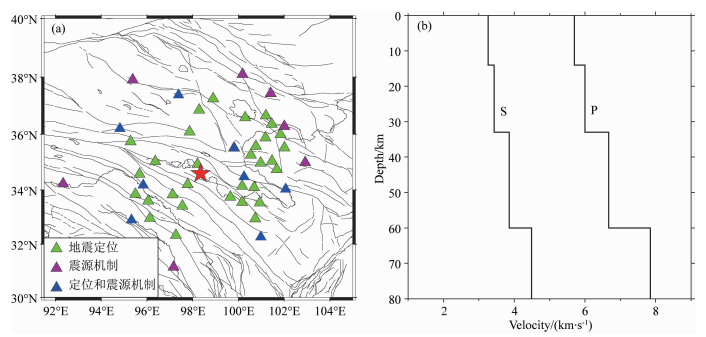
|
图 2 本研究所使用的(a)台站分布和(b)速度模型 Fig. 2 (a) Distribution of seismic stations and (b) Velocity models used in this study |
重定位后地震事件的水平位置显示(图 3a),玛多7.4级地震序列位于玛多—甘德断裂和甘德南缘断裂之间,余震序列整体呈SEE-NWW向条带状分布,与两条断裂走向近平行.余震自主震位置分别沿SEE向和NWW向展布,断层面整体破裂长度约180 km,且玛多地震序列在平面上并非连续,呈现出分段性特征;在主震东西两侧出现2处较明显的余震空区或稀疏区(图 3a中淡绿色椭圆所示).另外,地震序列东侧末端的余震数量较多,并表现出明显的多分支特征,相对SEE-NWW向的地震序列分布逆时针旋转约30°,最大余震分支呈近EW向分布,末端余震沿水平方向向东延伸,横穿玛多—甘德断裂和西藏大沟—昌马河断裂.重定位地震事件垂直剖面图显示(图 3b),震源深度主要分布在4~14 km深度范围内,均为浅源型地震,这可能是此次地震造成较多地表破裂的重要原因.穿过主震且垂直于余震展布方向的剖面FF′显示出发震断层接近直立(图 3c),横剖面BB′、CC′、DD′、EE′、GG′和HH′中余震同样显示发震断层较陡或者接近直立的特征,符合走滑型地震余震展布特征(房立华等,2015).在余震序列东侧尾端的JJ′剖面,可以清楚的看出,存在两个近垂直的断层面,并且震源深度相比其他地区有变深的趋势.结合主震震源机制的结果(张喆和许力生,2021),地震序列精定位空间展布与NWW断层面走向一致,我们推断玛多7.4级地震为一次高倾角的左旋走滑型地震,发震断层为一条位于玛多—甘德断裂与甘德南缘断裂之间的一条未知断裂.
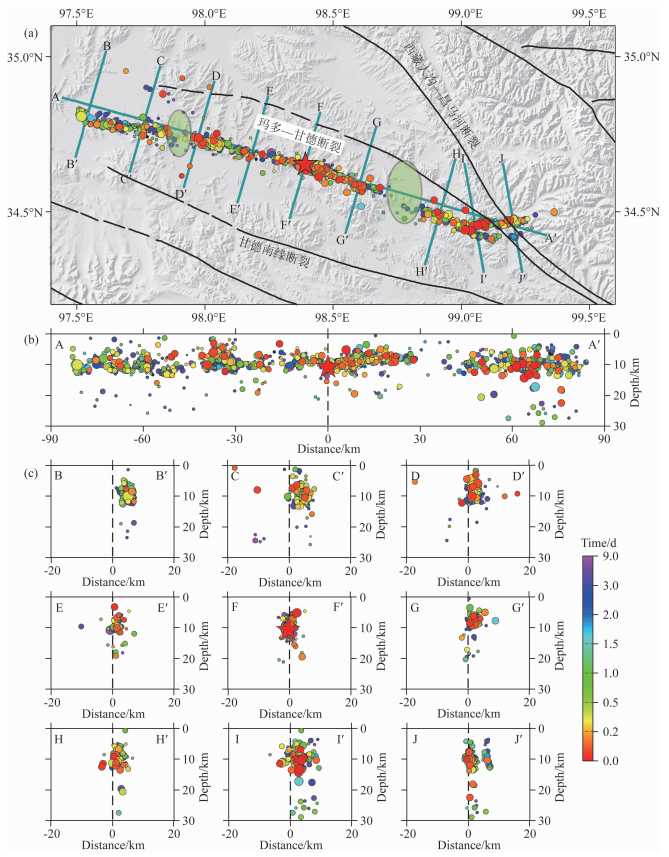
|
图 3 青海玛多地震序列重定位震中分布(a)与剖面图(b和c) 其中五角星表示玛多主震,圆圈表示余震,圆的大小对应震级大小,不同颜色代表余震相对主震的发生时间,AA′为沿余震走向方向的剖面,BB′、CC′、DD′、EE′、FF′、GG′和HH′为垂直余震走向的剖面,II′和JJ′为垂直末端余震走向的剖面;椭圆区域表示余震稀疏区. Fig. 3 Top view (a) and cross sections (b and c) maps of the relocated Madoi, Qinghai earthquake sequence Star denotes Madoi mainshock, circles are aftershocks, the size and color of which show magnitude and time after mainshock. AA′ is cross-section along the extending direction of aftershocks. BB′, CC′, DD′, EE′, FF′, GG′ and HH′ are perpendicular to the extending direction of aftershocks, II′ and JJ′ are perpendicular to the extending direction of end aftershocks; The ellipse denotes the sparse aftershock region. |
为了更好地了解玛多地震序列发震构造,我们利用近震全波形矩张量反演方法求取玛多MS4.0以上余震的震源机制解.本文选取了高信噪比、记录完整以及台站方位角和离源角均覆盖良好的宽频带数字台站的三分量波形资料进行震源机制反演.根据选取原则,共有15个台站参与震源机制反演(图 2a).在反演前,首先对原始波形做预处理,包括去除仪器响应、去倾斜、去平均值及滤波等处理.滤波频带上限频率主要受震中距、地震大小和地壳速度结构模型的影响,下限频率则应尽可能低,以降低背景噪声干扰.根据震级大小不同,选取不同滤波频带对波形记录进行二阶巴特沃斯带通滤波(表 1).
|
|
表 1 玛多7.4级地震中强余震震源参数表 Table 1 Source parameters of the moderate aftershocks of the Madoi MS7.4 earthquake |
反演过程中,采用双差重定位后的地震目录为参数,以震中位置为起始点,震源深度方向搜索范围为1~21 km,深度步长为1 km,矩心时间偏移的搜索范围设为发震时刻前后2.25 s,时间步长为0.1 s,采用双力偶机制反演模式,基于单一点源模型在时间和空间范围搜索震源机制最优解.将震源机制反演得到的波形互相关系数作为震源深度的函数,反演不同深度的震源机制解,以最大波形拟合系数相应的震源深度和震源机制解为最佳结果.其中震源机制反演采用和地震定位相同的一维速度模型(图 3b),应用离散波数法(Kennett and Kerry, 1979;Bouchon,1981)计算得到格林函数,采样频率为1 Hz.
我们以2021年5月22日玛多MS5.1地震为例,采用近震全波形反演方法,在双力偶机制模式下,进行震源机制反演.图 4给出该地震震源机制反演矩心深度与波形相关系数间的关系.从图 4中可以看出,地震震源机制类型在不同深度上变化不大,均显示为走滑型地震事件,在矩心深度5 km处,波形相关系数最大,此时矩心时间相对于发震时刻向后移动约1 s.最终反演所得玛多MS5.1地震震源机制节面Ⅰ的走向、倾角和滑动角为26°、65°和163°,节面Ⅱ的走向、倾角和滑动角为123°、75°和26°,矩心深度5 km,矩震级MW为5.0.图 5给出了该地震震源机制反演理论波形和观测波形对比图,由图可以看出,观测波形和理论波形的拟合度较高,其对应波形的拟合图方差减少量(VR)为0.84(表 1),其中VR(Variance Reduction)为方差减少量,定义为:


|
图 4 2021年5月22日玛多MS5.1地震矩心深度与波形互相关关系 Fig. 4 Centroid depth and cross-correlation coefficient of the Madoi MS5.1 earthquake on May 22, 2021 |
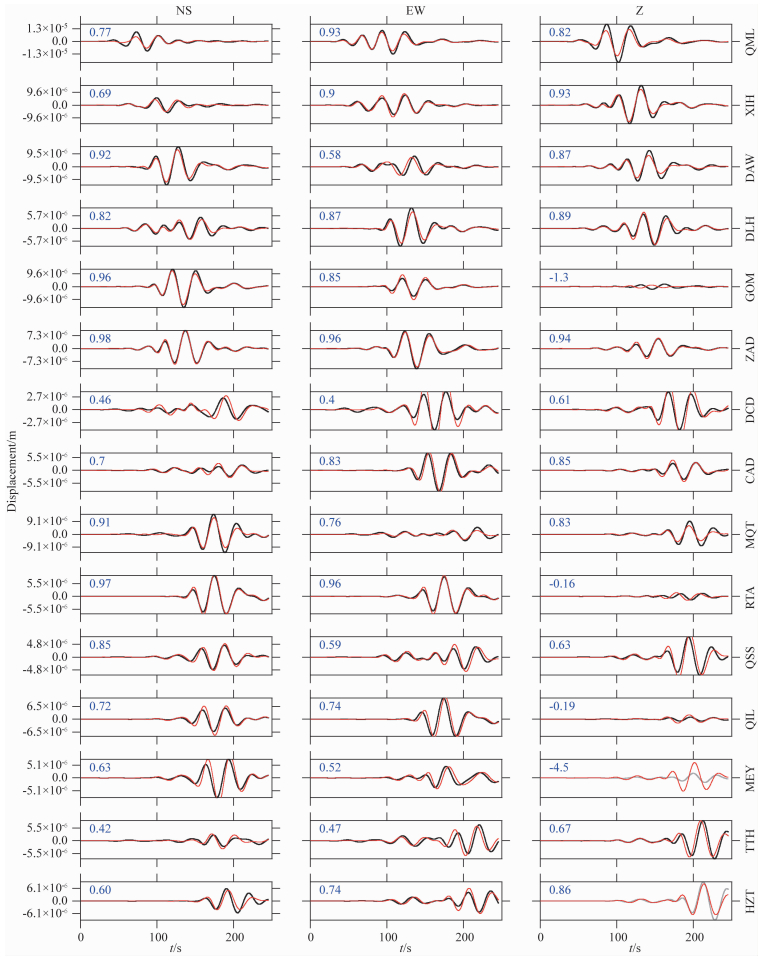
|
图 5 玛多MS5.1地震最佳反演结果对应的观测波形(黑色)与拟合波形(红色)比较图 Fig. 5 Comparison of observed (black) and synthetic (red) waveform for the Madoi MS5.1 earthquake corresponding to the best inversion results |
经过对青海玛多7.4级余震事件波形的仔细筛选,本文得到了15个MS≥4.0余震事件的震源机制解,具体震源参数如表 1和图 6所示.需要说明的是,主震发生后,截至2021年5月30日,震源区共发生17次MS≥4.0的中强余震,但由于2次余震(22日03时03分,22日03时49分)信号完全淹没在持续振荡的主震尾波中,导致记录台站信噪比低,很难得到这2次地震的震源机制结果.
为了评估所得震源机制的稳定性,我们采用大折刀法对本研究所得15次地震进行断层面参数不确定性分析(Boyd et al.,2015).具体而言,每一个地震事件在选择参加反演的15个台站中,按照依次减少一个台站(图 6a)或一个分量(图 6b)波形资料进行多次反演.图 6将所有反演震源机制投影到同一个震源球上,由该图可以看出,所有地震事件断层面节面线分布均较为集中,说明多次反演结果比较稳定,反演结果可信.
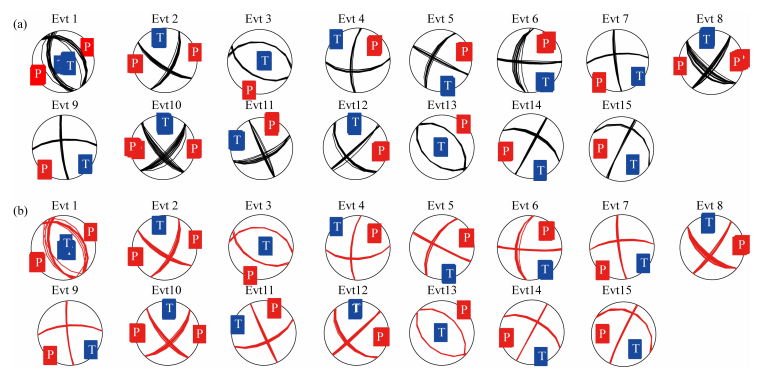
|
图 6 采用大折刀法分析断层面参数不确定性 沙滩球上方字符串表示表 1中对应的地震序号,黑线和红线表示不同数据组反演震源机制解所对应的节面.(a) 每次反演减少1个台站;(b) 每次反演减少1个分量. Fig. 6 Uncertainties analysis of fault plane parameters using Jackknife method The numbers above the beach ball correspond to the index numbers of earthquakes listed in the Table 1, the node planes obtained from different data sets for inversion of focal mechanism solutions are drawn by black line and red line. (a) Removing one station at each inversion; (b) Removing one component at each inversion. |
震源机制解反演结果表明(图 7),玛多地震中强余震序列震源错动较为简单,断层运动多为走滑型,表明玛多震源区内变形主要以平移错动为主.但是,这些地震的断层面走向却具有差异性.玛多MS7.4主震与3次余震震源机制解(事件4、事件7和事件9)比较接近,其实际发震断层面走向与余震展布方向相一致.位于主震西侧的地震事件2、8、10、12和14震源机制的走向和倾角显著变化,说明发震断层面并非简单的平面结构.另外,主震东侧末端的事件3和13均为逆冲型事件,表现为挤压变形特征,从余震的分布来看,该区域断层破裂方向转为NEE,在断层弯曲转换处产生了挤压型地震.此次玛多7.4级地震序列震源类型的不同,反映了震源应力场的变化(魏柏林,1980),表明后期的余震活动与发震并不局限于主震的破裂机制,会受到局部应力调整从而形成新的震源破裂机制.事件5和事件6位于主震破裂区外围的东昆仑断裂和布尔汗布达山—昆仑中断裂,表现为近直立的左旋走滑型地震,推测可能是玛多7.4级地震触发的地震活动.

|
图 7 玛多MS7.4主震和部分中强余震震源机制解平面和剖面图 Fig. 7 Top view (a) and cross-section (b) maps showing the focal mechanism solutions of the Madoi MS7.4 mainshock and partial moderate strong aftershocks |
青海玛多7.4级主震震源区应力状态如何?主余震序列震源机制解所反映的构造应力状态是否与区域整体背景应力场一致?为了详细探究以上问题,本文采用Vavryuk(2014)给出的应力和断层面方向联合迭代反演算法,利用本研究得到的15次地震的震源机制解,迭代反演获取玛多7.4级地震震源区构造应力场.为约束应力场反演结果的稳定性,采用输入的走向角、倾角和滑动角参数,计算断层法向矢量和滑动矢量,在断层法向和滑动方向加入标准偏差为10°的随机噪声值,加入随机噪声的断层法向矢量和滑动矢量相互垂直.经过200次迭代联合反演,我们获得了如图 8所示的稳定结果.

|
图 8 玛多地震序列震源处应力场反演 (a) P/T轴;(b) 主应力轴置信. Fig. 8 Stress field inversion in focal region of the Madoi earthquake sequence (a) P/T axes; (b) Confidence of principal stress axes. |
从应力体系上看,震源区最大水平主压应力轴σ1的方位为NEE向(58°),倾伏角为5°;中间压应力轴σ2的方位为NWW向(323°),倾伏角为41°;最小主压应力轴σ3的方位为SSE向(154°),倾伏角为48°(图 8b).应力场反演结果表明,研究区域整体的背景应力场具有近EW向挤压应力场特征,与巴颜喀拉块体的水平最大主应力方向总体上为东西向(范桃园等,2013)具有较好的一致性,反映了青藏高原持续受到印度板块向欧亚板块俯冲挤压的构造应力场的影响,表现为巴颜喀拉地块现今整体向东方向运动的特征,出现构造逃逸现象.此外,应力场反演还给出了3个主应力轴σ1、σ2和σ3的相对应力大小值为0.96,即应力形因子值R(R=(σ1-σ2)/(σ1-σ3)),应力形因子值R接近1,表明σ1≫σ2≈σ3.同时,震源区水平最大主应力轴σ1分布集中(图 8b),倾伏角近水平,而其他两个主应力轴σ2、σ3分布比较分散,具有高倾伏角,表明应力体系走滑和逆断层性质同时存在,与震源区震源机制既有走滑型又有挤压型较为一致.
2 讨论 2.1 余震序列时空分布特征本研究采用双差定位方法获得玛多7.4级地震序列1055个事件的精定位结果.重定位结果显示,余震分别沿NWW向和SEE向展布,破裂长度约180 km,且主震发生后的2 h内主要分布在东侧,表明主震造成的断层破裂为不对称双侧扩展模式.在整个断裂带上,余震分布表现出明显的非均匀性,比如在主震的东侧存在约15 km的余震空区(图 3a).有限断层反演结果显示该区域是断层深部滑移量较大区域(http://www.cea-igp.ac.cn/),可能暗示在主震引发的断层破裂过程中该段能量得以充分释放,因此产生的余震个数较少.另外,在主震的西侧也存在有多个余震稀疏区,结合震源机制解断层面倾角的变化,我们推测断层破裂面并非简单的平面结构,可能存在凹凸体(易桂喜等,2019),断层面结构的复杂性造成了余震空间分布表现出分段的密集分布特征(图 3b).余震扩展的另外一个显著特征是在断层的两端出现多个分支破裂,比如在主震东侧末端,余震序列显示出两条与主震断层不一致的扩展方向,优势方向由SEE转为NEE,且两条分支破裂近平行,切穿了北西向的玛多—甘德和西藏大沟—昌马河断裂.同样,在发震断层的西侧末端,出现了偏离主断裂的NW向余震条带,表明玛多7.4级地震触发了分支断层活动.玛多7.4级地震丰富的余震序列,与震源区复杂的地质构造密切相关.比如震源区存在的玛多—甘德和西藏大沟—昌马河等近平行断裂,且主震东部与多条断层交汇,在这样的构造背景下更易于产生分支断层破裂而导致后续余震的频繁发生.
2.2 发震断层结构震源机制反演结果显示,玛多地震中强余震序列震源错动多为走滑型,表明震源区内变形或破裂主要以水平错动为主.但是,这些地震的断层面走向和倾角却有显著的变化(图 7),表明大型走滑型地震发生时,复杂的平移错动引起的浅部破裂面和深部破裂面是存在差异的.为此,结合余震分布及震源机制解,我们给出玛多7.4级地震发震断层的结构示意图(图 9),并采用精定位地震空间位置,拟合获得断层不同位置的倾角(万永革等,2008;盛书中等, 2014),整体上发震断层面较为陡立,但沿断裂方向倾角存在一定的变化.值得注意的是,在破裂的两端结构更为复杂,比如在主震破裂的东侧,靠近玛多—甘德断裂和西藏大沟—昌马河断裂的两次余震表现为逆断性质,具有挤压变形特征,该区域也是余震序列扩展方向转变的区域(图 3a),与主震相比,这两次余震的震源性质发生了变化.我们推测,在主震发生时,走滑型破裂面尾端可能受到东侧两条断层或东南侧相对强硬物质的阻挡,局部受到挤压变形从而在东端部产生了挤压型地震(图 9).
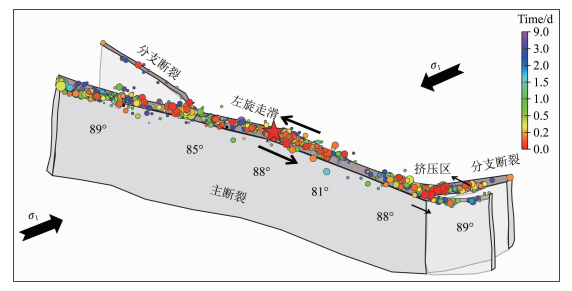
|
图 9 玛多MS7.4地震发震断层结构示意图 其中σ1表示最大主压应力方向,主断裂不同位置数字代表分段断层倾角. Fig. 9 Sketch of seismogenic fault structure of Madoi MS7.4 earthquake σ1 indicates the direction of maximum principal compressional stress. The numbers in the fault plane represent the dip angles of fault segments. |
区域应力场反演结果表明,玛多震区构造应力场最大主压应力轴为近东西向,具有低倾伏角特征,与地表GPS速度场反映的运动方向具有较好的一致性(Wang and Shen, 2020),表明青藏高原持续受到印度板块向欧亚板块挤压的构造应力场影响.现今巴颜喀拉块体整体表现出往东方向的运动特征,此次玛多7.4级地震是巴颜喀拉地块最新活动的结果,反映了巴颜喀拉地块的东向“逃逸”运动(Xu et al., 2013a;闻学泽,2018).巴颜喀拉地块位于青藏高原中北部,是青藏高原构造活动最强地区.近20年来,青藏高原的强震活动均分布在巴颜喀拉地块
周缘边界(图 1),但巴颜喀拉块体内部地震并不活跃,仅在1947年发生一次M7.7达日地震(梁明剑等,2020;刘雷等,2021).深部速度结构结果显示,在玛多MS7.4地震震源区下方20~40 km存在显著的低速异常体(Xin et al., 2019; Huang et al., 2020),暗示深部结构异常对浅部地震发生具有一定的影响,中下地壳相对软弱的物质流(Clark and Royden, 2000)更容易导致上覆脆性层存储能量.综上我们认为印度板块向北俯冲挤压欧亚板块的长期应力积累(邓起东等,2010;2014;高翔和邓起东,2013)和中下地壳低速物质(王椿镛等,2008;嘉世旭等,2017)的共同作用是玛多7.4级地震的动力来源.关于玛多7.4级地震,也给予我们一些启示,在关注大地震空区及水平滑移速率较大块体边界带的同时,也需重视地表相对滑动速率偏低的块体内部区域.此次玛多7.4级地震所处的巴颜喀拉块体虽然整体上滑动速率约~10 mm·a-1(Wang and Shen, 2020),但在块体内部震源区的相对滑动速率较低.类似于2008年汶川8.0级地震,在震前横跨整个龙门山断裂带的滑动速率不超过~2 mm·a-1,但却产生了地表破裂近300 km的破坏性大震(张培震等,2008),因此我们推测浅部的水平运动与深部的能量积累可能存在差异.前人大量研究结果表明深部流体或低速物质沿断裂等薄弱带的向浅部侵入对地震的发生具有显著的触发作用(雷建设等, 2009;吴建平等, 2009;李志伟等,2011;郑勇等, 2013;Zhang et al., 2019),结合最新的大地电磁测深结果揭示的玛多震源区下方广泛分布的低速高导层(詹艳等,2021),本研究认为此次MS7.4地震孕震层下方的低速异常(Xin et al., 2019; Huang et al., 2020)可能是强震发生的主要触发因素.
3 结论本研究对2021年5月22日青海玛多7.4级地震开展余震序列精定位、中强地震震源机制和区域应力场研究,结果展示出发震断层破裂延展长度约180 km, 主震为左旋走滑型机制;主震处断层面较为陡立,但沿断裂方向断层面倾角具有明显变化,结合余震时空分布的非均匀性,暗示发震断层面的几何形态并非简单的平面结构;另外,主震触发了东西两端的分支断裂活动,表明震源区断层系统较复杂.此次玛多7.4级地震更加印证了印度板块与欧亚板块的持续碰撞作用,说明巴颜喀拉块体仍处在活跃期.
致谢 感谢评审专家提出的宝贵修改意见;感谢编辑部的高效评审;感谢中国地震台网中心、青海省地震局等相关工作人员在震后夜以继日的辛苦工作,为本研究提供了宝贵的震相观测资料和地震波形数据.
Bouchon M. 1981. A simple method to calculate Green's functions for elastic layered media. Bulletin of the Seismological Society of America, 71(4): 959-971. DOI:10.1785/BSSA0710040959 |
Boyd O S, Dreger D S, Lai V H, et al. 2015. A systematic analysis of seismic moment tensor at The Geysers geothermal field, California. Bulletin of the Seismological Society of America, 105(6): 2969-2986. DOI:10.1785/0120140285 |
Clark M K, Royden L H. 2000. Topographic ooze: Building the eastern margin of Tibet by lower crustal flow. Geology, 28(8): 703-706. DOI:10.1130/0091-7613(2000)28<703:TOBTEM>2.0.CO;2 |
Deng Q D, Gao X, Chen G H, et al. 2010. Recent tectonic activity of Bayankala fault-block and the Kunlun-Wenchuan earthquake series of the Tibetan Plateau. Earth Science Frontiers (in Chinese), 17(5): 163-178. |
Deng Q D, Cheng S P, Ma J, et al. 2014. Seismic activities and earthquake potential in the Tibetan plateau. Chinese Journal of Geophysics (in Chinese), 57(7): 2025-2042. DOI:10.6038/cjg20140701 |
Fan T Y, Chen Q C, Wu Z H, et al. 2013. 3D viscoelastic modeling on the present crustal stress of eastern Qingzang Plateau including active tectonics. Progress in Geophysics (in Chinese), 28(3): 1140-1149. DOI:10.6038/pg20130305 |
Fang L H, Wu J P, Wang W L, et al. 2013. Relocation of the mainshock and aftershock sequences of MS7.0 Sichuan Lushan earthquake. Chinese Science Bulletin, 58(28-29): 3451-3459. DOI:10.1007/s11434-013-6000-2 |
Fang L H, Wu J P, Wang W L, et al. 2015. Relocation of the 2014 MS7.3 earthquake sequence in Yutian, Xinjiang. Chinese Journal of Geophysics (in Chinese), 58(3): 802-808. DOI:10.6038/cjg20150310 |
Gao X, Deng Q D. 2013. Activity analysis of large earthquakes in boundary faults around the Bayankala faulting block. Acta Geologica Sinica (in Chinese), 87(1): 9-19. |
Huang S Y, Yao H J, Lu Z W, et al. 2020. High-resolution 3-D shear wave velocity model of the Tibetan plateau: implications for crustal deformation and porphyry Cu deposit formation. Journal of Geophysical Research: Solid Earth, 125(7): e2019JB019215. DOI:10.1029/2019JB019215 |
Jia S X, Lin J Y, Guo W B, et al. 2017. Investigation on diversity of crustal structures beneath the Bayan Har block. Chinese Journal of Geophysics (in Chinese), 60(6): 2226-2238. DOI:10.6038/cjg20170616 |
Kennett B L N, Kerry N J. 1979. Seismic waves in a stratified half space. Geophysical Journal International, 57(3): 557-583. DOI:10.1111/j.1365-246X.1979.tb06779.x |
Lei J S, Zhao D P, Su J R, et al. 2009. Fine seismic structure under the Longmenshan fault zone and the mechanism of the large Wenchuan earthquake. Chinese Journal of Geophysics (in Chinese), 52(2): 339-345. |
Li Z W, Xu Y, Huang R Q, et al. 2011. Crustal P-wave velocity structure of the Longmenshan region and its tectonic implications for the 2008 Wenchuan earthquake. Science China Earth Sciences, 54(9): 1386-1393. DOI:10.1007/s11430-011-4177-2 |
Liang M J, Yang Y, Du F, et al. 2020. Late quaternary activity of the central segment of the Dari fault and restudy of the surface rupture zone of the 1947 M73/4 Dari earthquake, Qinghai province. Seismology and Geology (in Chinese), 42(3): 703-714. |
Liang S S, Lei J S, Xu Z G, et al. 2018. Relocation of aftershocks of the 2017 Jiuzhaigou, Sichuan, MS7.0 earthquake and inversion for focal mechanism of the mainshock. Chinese Journal of Geophysics (in Chinese), 61(5): 2163-2175. DOI:10.6038/cjg2018L0508 |
Liu J, Yi G X, Zhang Z W, et al. 2013. Introduction to the Lushan, Sichuan M7.0 earthquake on 20 April 2013. Chinese Journal of Geophysics (in Chinese), 56(4): 1404-1407. DOI:10.6038/cjg20130434 |
Liu L, Li Y J, Zhu L Y, et al. 2021. Influence of the 1947 Dari M7.7 earthquake on stress evolution along the boundary fault of the Bayan Har block: insights from numerical simulation. Chinese Journal of Geophysics (in Chinese), 64(7): 2221-2231. DOI:10.6038/cjg2021P0194 |
Sheng S Z, Wan Y G, Wang W L, et al. 2014. The fault plane parameter determination of the 2010 Yushu MS7.1 earthquake. Progress in Geophysics (in Chinese), 29(4): 1555-1562. DOI:10.6038/pg20140409 |
Sokos E N, Zahradnik J. 2008. ISOLA a Fortran code and a Matlab GUI to perform multiple-point source inversion of seismic data. Computers & Geosciences, 34(8): 967-977. |
Sokos E, Zahradník J. 2013. Evaluating centroid-moment-tensor uncertainty in the new version of ISOLA software. Seismological Research Letters, 84(4): 656-665. DOI:10.1785/0220130002 |
Sun X Z, Xu X W, Chen L C, et al. 2012. Surface rupture features of the 2010 Yushu earthquake and its tectonic implication. Chinese Journal of Geophysics (in Chinese), 55(1): 155-170. DOI:10.6038/j.issn.0001-5733.2012.01.015 |
Tapponnier P, Peltzer G, Le Dain A Y, et al. 1982. Propagating extrusion tectonics in Asia: New insights from simple experiments with plasticine. Geology, 10(12): 611-616. DOI:10.1130/0091-7613(1982)10<611:PETIAN>2.0.CO;2 |
Vavryčuk V. 2014. Iterative joint inversion for stress and fault orientations from focal mechanisms. Geophysical Journal International, 199(1): 69-77. DOI:10.1093/gji/ggu224 |
Waldhauser F, Ellsworth W L. 2000. A double-difference earthquake location algorithm: Method and application to the northern Hayward fault, California. Bulletin of the Seismological Society of America, 90(6): 1353-1368. DOI:10.1785/0120000006 |
Wan Y G, Shen Z K, Diao G L, et al. 2008. An algorithm of fault parameter determination using distribution of small earthquakes and parameters of regional stress field and its application to Tangshan earthquake sequence. Chinese Journal of Geophysics (in Chinese), 51(3): 793-804. DOI:10.3321/j.issn:0001-5733.2008.03.020 |
Wan Y G, Shen Z K, Sheng S Z, et al. 2009. The influence of 2008 Wenchuan earthquake on surrounding faults. Acta Seismologica Sinica (in Chinese), 31(2): 128-139. |
Wang C Y, Lou H, Lv Z Y, et al. 2008. S-wave crustal and upper mantle's velocity structure in the eastern Tibetan Plateau-Deep environment of lower crustal flow. Science in China Series D: Earth Sciences, 51(2): 263-274. DOI:10.1007/s11430-008-0008-5 |
Wang M, Shen Z K. 2020. Present-day crustal deformation of continental China derived from GPS and its tectonic implications. Journal of Geophysical Research: Solid Earth, 125(2): e2019JB018774. DOI:10.1029/2019JB018774 |
Wang W L, Wu J P, Fang L H, et al. 2013. Relocation of the Yushu MS7.1 earthquake and its aftershocks in 2010 from HypoDD. Science China Earth Sciences, 56(2): 182-191. DOI:10.1007/s11430-012-4450-z |
Wei B L. 1980. Cause of the change of focal mechanisms of aftershocks. Chinese Journal of Geophysics (Acta Geophysica Sinica) (in Chinese), 23(1): 25-34. |
Wen X Z. 2018. The 2008 Wenchuan, 2013 Lushan and 2017 Jiuzhaigou earthquakes, Sichuan, in the last more than one thousand years of rupture history of the eastern margin of the Bayan Har block. Acta Seismologica Sinica (in Chinese), 40(3): 255-267. |
Wu J P, Huang Y, Zhang T Z, et al. 2009. Aftershock distribution of the MS8.0 Wenchuan earthquake and three dimensional P-wave velocity structure in and around source region. Chinese Journal of Geophysics (in Chinese), 52(2): 320-328. |
Xin H L, Zhang H J, Kang M, et al. 2019. High-resolution lithospheric velocity structure of continental china by double-difference seismic travel-time tomography. Seismological Research Letters, 90(1): 229-241. DOI:10.1785/0220180209 |
Xu X W, Chen W B, Ma W T, et al. 2002. Surface rupture of the Kunlunshan earthquake (MS8.1), northern Tibetan plateau, China. Seismological Research Letters, 73(6): 884-892. DOI:10.1785/gssrl.73.6.884 |
Xu X W, Yu G H, Ma W T, et al. 2008a. Rupture behavior and deformation localization of the Kunlunshan earthquake (MW7.8) and their tectonic implications. Science in China Series D: Earth Sciences, 51(10): 1361-1374. DOI:10.1007/s11430-008-0099-z |
Xu X W, Wen X Z, Ye J Q, et al. 2008b. The MS8.0 Wenchuan earthquake surface ruptures and its seismogenic structure. Seismology and Geology (in Chinese), 30(3): 597-629. |
Xu X W, Tan X B, Yu G H, et al. 2013a. Normal-and oblique-slip of the 2008 Yutian earthquake: evidence for eastward block motion, northern Tibetan Plateau. Tectonophysics, 584: 152-165. DOI:10.1016/j.tecto.2012.08.007 |
Xu X W, Wen X Z, Han Z J, et al. 2013b. Lushan MS7.0 earthquake: A blind reserve-fault event. Chinese Science Bulletin, 58(28-29): 3437-3443. DOI:10.1007/s11434-013-5999-4 |
Xu X W, Han Z J, Yang X P, et al. 2016. Seismotectonic Atlas of China and Its Vicinity (in Chinese). Beijing: Seismological Press.
|
Xu X W, Chen G H, Wang Q X, et al. 2017. Discussion on seismogenic structure of Jiuzhaigou earthquake and its implication for current strain state in the southeastern Qinghai-Tibet Plateau. Chinese Journal of Geophysics (in Chinese), 60(10): 4018-4026. DOI:10.6038/cjg20171028 |
Yang Y H, Fan J, Hua Q, et al. 2017. Inversion for the focal mechanisms of the 2017 Jiuzhaigou M7.0 earthquake sequence using near-field full waveforms. Chinese Journal of Geophysics (in Chinese), 60(10): 4098-4104. DOI:10.6038/cjg20171034 |
Yi G X, Long F, Qiao M J, et al. 2017. Focal mechanism solutions and seismogenic structure of the 8 August 2017 M7.0 Jiuzhaigou earthquake and its aftershocks, northern Sichuan. Chinese Journal of Geophysics (in Chinese), 60(10): 4083-4097. DOI:10.6038/cjg20171033 |
Yi G X, Long F, Liang M J, et al. 2019. Focal mechanism solutions and seismogenic structure of the 17 June 2019 MS6.0 Sichuan Changning earthquake sequence. Chinese Journal of Geophysics (in Chinese), 62(9): 3432-3447. DOI:10.6038/cjg2019N0297 |
Zhan Y, Liang M J, Sun X Y, et al. 2021. Deep structure and seismogenic pattern of the 2021.5.22 Madoi (Qinghai) MS7.4 earthquake. Chinese Journal of Geophysics (in Chinese), 64(7): 2232-2252. DOI:10.6038/cjg2021O0521 |
Zhang G M, Li X B, Zheng C, et al. 2019. Crustal and uppermost mantle velocity structure beneath the central-eastern Tibetan Plateau from P-wave tomography. Acta Seismologica Sinica (in Chinese), 41(4): 411-424. |
Zhang G W, Lei J S. 2013. Relocations of Lushan, Sichuan strong earthquake (MS7.0) and its aftershocks. Chinese Journal of Geophysics (in Chinese), 56(5): 1764-1771. DOI:10.6038/cjg20130534 |
Zhang G W, Lei J S, Sun C Q. 2014. Relocation of the 12 February 2014 Yutian, Xinjiang, mainshock (MS7.3) and its aftershock. Chinese Journal of Geophysics (in Chinese), 57(3): 1012-1020. DOI:10.6038/cjg20140330 |
Zhang G W, Lei J S, Sun D Y. 2019. The 2013 and 2017 MS5 seismic swarms in Jilin, NE China: fluid-triggered earthquakes?. Journal of Geophysical Research: Solid Earth, 124(12): 13096-1311. DOI:10.1029/2019JB018649 |
Zhang P Z, Xu X W, Wen X Z, et al. 2008. Slip rates and recurrence intervals of the Longmen Shan active fault zone, and tectonic implications for the mechanism of the May 12 Wenchuan earthquake, 2008, Sichuan, China. Chinese Journal of Geophysics (in Chinese), 51(4): 1066-1073. |
Zhang Z, Xu L S. 2021. The centroid moment tensor solution of the 2021 MS7.5 Guoluo, Qinghai, earthquake. Acta Seismologica Sinica (in Chinese), 43(3): 1-5. |
Zheng Y, Ma H S, Lv J, et al. 2009. Source mechanism of strong aftershocks (MS ≥ 5.6) of the 2008/05/12 Wenchuan earthquake and the implication for seismotectonics. Science in China Series D: Earth Sciences, 52(6): 739-753. DOI:10.1007/s11430-009-0074-3 |
Zheng Y, Ge C, Xie Z J, et al. 2013. Crustal and upper mantle structure and the deep seismogenic environment in the source regions of the Lushan earthquake and the Wenchuan earthquake. Science China Earth Sciences, 56(7): 1158-1168. DOI:10.1007/s11430-013-4641-2 |
邓起东, 高翔, 陈桂华, 等. 2010. 青藏高原昆仑-汶川地震系列与巴颜喀喇断块的最新活动. 地学前缘, 17(5): 163-178. |
邓起东, 程绍平, 马骥, 等. 2014. 青藏高原地震活动特征及当前地震活动形势. 地球物理学报, 57(7): 2025-2042. DOI:10.6038/cjg20140701 |
范桃园, 陈群策, 吴中海, 等. 2013. 青藏高原东缘活动构造与现今地应力场三维粘弹性模拟研究. 地球物理学进展, 28(3): 1140-1149. DOI:10.6038/pg20130305 |
房立华, 吴建平, 王未来, 等. 2013. 四川芦山MS7.0级地震及其余震序列重定位. 科学通报, 58(20): 1901-1909. |
房立华, 吴建平, 王未来, 等. 2015. 2014年新疆于田MS7.3级地震序列重定位. 地球物理学报, 58(3): 802-808. DOI:10.6038/cjg20150310 |
高翔, 邓起东. 2013. 巴颜喀喇断块边界断裂强震活动分析. 地质学报, 87(1): 9-19. DOI:10.3969/j.issn.0001-5717.2013.01.002 |
嘉世旭, 林吉焱, 郭文斌, 等. 2017. 巴颜喀拉块体地壳结构多样性探测. 地球物理学报, 60(6): 2226-2238. DOI:10.6038/cjg20170616 |
雷建设, 赵大鹏, 苏金蓉, 等. 2009. 龙门山断裂带地壳精细结构与汶川地震发震机理. 地球物理学报, 52(2): 339-345. |
李志伟, 胥颐, 黄润秋, 等. 2011. 龙门山地区的P波速度结构与汶川地震的深部构造特征. 中国科学: 地球科学, 41(3): 283-290. |
梁明剑, 杨耀, 杜方, 等. 2020. 青海达日断裂中段晚第四纪活动性与1947年M73/4地震地表破裂带再研究. 地震地质, 42(3): 703-714. DOI:10.3969/j.issn.0253-4967.2020.03.011 |
梁姗姗, 雷建设, 徐志国, 等. 2018. 2017年四川九寨沟MS7.0强震的余震重定位及主震震源机制反演. 地球物理学报, 61(5): 2163-2175. DOI:10.6038/cjg2018L0508 |
刘杰, 易桂喜, 张致伟, 等. 2013. 2013年4月20日四川芦山M7.0级地震介绍. 地球物理学报, 56(4): 1404-1407. DOI:10.6038/cjg20130434 |
刘雷, 李玉江, 朱良玉, 等. 2021. 1947年达日M7.7地震对巴颜喀拉块体边界断裂应力影响的数值模拟. 地球物理学报, 64(7): 2221-2231. DOI:10.6038/cjg2021P0194 |
盛书中, 万永革, 王未来, 等. 2014. 2010年玉树MS7.1地震发震断层面参数的确定. 地球物理学进展, 29(4): 1555-1562. DOI:10.6038/pg20140409 |
孙鑫喆, 徐锡伟, 陈立春, 等. 2012. 2010年玉树地震地表破裂带典型破裂样式及其构造意义. 地球物理学报, 55(1): 155-170. DOI:10.6038/j.issn.0001-5733.2012.01.015 |
万永革, 沈正康, 刁桂苓, 等. 2008. 利用小震分布和区域应力场确定大震断层面参数方法及其在唐山地震序列中的应用. 地球物理学报, 51(3): 793-804. DOI:10.3321/j.issn:0001-5733.2008.03.020 |
万永革, 沈正康, 盛书中, 等. 2009. 2008年汶川大地震对周围断层的影响. 地震学报, 31(2): 128-139. DOI:10.3321/j.issn:0253-3782.2009.02.002 |
王椿镛, 楼海, 吕智勇, 等. 2008. 青藏高原东部地壳上地幔S波速度结构——下地壳流的深部环境. 中国科学D辑: 地球科学, 38(1): 22-32. DOI:10.3321/j.issn:1006-9267.2008.01.003 |
王未来, 吴建平, 房立华, 等. 2012. 2010年玉树MS7.1地震及其余震的双差定位研究. 中国科学: 地球科学, 42(7): 1037-1046. |
魏柏林. 1980. 余震震源机制变化的原因. 地球物理学报, 23(1): 25-34. DOI:10.3321/j.issn:0001-5733.1980.01.004 |
闻学泽. 2018. 巴颜喀拉块体东边界千年破裂历史与2008年汶川、2013年芦山和2017年九寨沟地震. 地震学报, 40(3): 255-267. |
吴建平, 黄媛, 张天中, 等. 2009. 汶川MS8.0级地震余震分布及周边区域P波三维速度结构研究. 地球物理学报, 52(2): 320-328. |
徐锡伟, 于贵华, 马文涛, 等. 2008a. 昆仑山地震(MW7.8)破裂行为、变形局部化特征及其构造内涵讨论. 中国科学D辑: 地球科学, 38(7): 785-796. |
徐锡伟, 闻学泽, 叶建青, 等. 2008b. 汶川MS8.0地震地表破裂带及其发震构造. 地震地质, 30(3): 597-629. |
徐锡伟, 韩竹军, 杨小平, 等. 2016. 中国及邻近地区地震构造图. 北京: 地震出版社.
|
徐锡伟, 陈桂华, 王启欣, 等. 2017. 九寨沟地震发震断层属性及青藏高原东南缘现今应变状态讨论. 地球物理学报, 60(10): 4018-4026. DOI:10.6038/cjg20171028 |
杨宜海, 范军, 花茜, 等. 2017. 近震全波形反演2017年九寨沟M7.0地震序列震源机制解. 地球物理学报, 60(10): 4098-4104. DOI:10.6038/cjg20171034 |
易桂喜, 龙锋, 梁明剑, 等. 2017. 2017年8月8日九寨沟M7.0地震及余震震源机制解与发震构造分析. 地球物理学报, 60(10): 4083-4097. DOI:10.6038/cjg20171033 |
易桂喜, 龙锋, 梁明剑, 等. 2019. 2019年6月17日四川长宁MS6.0地震序列震源机制解与发震构造分析. 地球物理学报, 62(9): 3432-3447. DOI:10.6038/cjg2019N0297 |
詹艳, 梁明剑, 孙翔宇, 等. 2021. 2021年5月22日青海玛多MS7.4地震深部环境及发震构造模式. 地球物理学报, 64(7): 2232-2252. DOI:10.6038/cjg2021O0521 |
张戈铭, 李细兵, 郑晨, 等. 2019. 青藏高原中东部地壳和上地幔顶部P波层析成像. 地震学报, 41(4): 411-424. |
张广伟, 雷建设. 2013. 四川芦山7.0级强震及其余震序列重定位. 地球物理学报, 56(5): 1764-1771. DOI:10.6038/cjg20130534 |
张广伟, 雷建设, 孙长青. 2014. 2014年2月12日新疆于田MS7.3级地震主震及余震序列重定位研究. 地球物理学报, 57(3): 1012-1020. DOI:10.6038/cjg20140330 |
张培震, 徐锡伟, 闻学泽, 等. 2008. 2008年汶川8.0级地震发震断裂的滑动速率, 复发周期和构造成因. 地球物理学报, 51(4): 1066-1073. DOI:10.3321/j.issn:0001-5733.2008.04.015 |
张喆, 许立生. 2021. 2021年青海果洛MW7.5地震矩心矩张量解. 地震学报, 43(3): 1-5. |
郑勇, 马宏生, 吕坚, 等. 2009. 汶川地震强余震(MS ≥ 5.6)的震源机制解及其与发震构造的关系. 中国科学D辑: 地球科学, 39(4): 413-426. |
郑勇, 葛粲, 谢祖军, 等. 2013. 芦山与汶川地震震区地壳上地幔结构及深部孕震环境. 中国科学: 地球科学, 43(6): 1027-1037. |
 2021, Vol. 64
2021, Vol. 64


